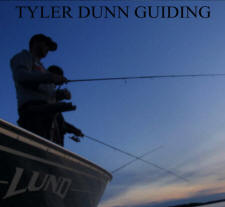|

|
 Early
Season Minnow Bait Walleye Early
Season Minnow Bait Walleye
By: Tyler Dunn
Tyler Dunn Guiding
The most exciting time of the year for a diehard
walleye fisherman is most definitely spring.
With the anticipation of the walleye opener just
around the corner, most throughout the province
have been fantasizing about the upcoming golden
adventures since the ice was around. Many will
suggest that a jig and minnow is the most
productive bait for spring walleye. I don’t
disagree. It is definitely the most efficient
tactic when you know where the fish are. New and
even big bodies of water can often present the
challenge of covering huge portions of the water
body before you can “sit” on them. The following
tips are for minnow baits which are very popular
during the fall but can be often overlooked as
an early season walleye lure.
Location
Post-spawn walleye can be found in many
places throughout a lake or river system.
Pre-spawn spots like river or creek mouths will
still have fish around but more than likely
these will be males which are usually on the
smaller side. Not only will classic early season
spots hold walleye
but summer spots such as deep water humps, rocky
shoals and even the basin will hold fish and
usually the big ones. Big female walleyes
receive first choice of an ideal spawn area, do
their thing and then quickly move back into the
lake. This is the point where spawning is
finally off the mind of the fish and feeding is
now back as the top priority. Opposite of the
day, night will bring these deep aggressive fish
into the shallows. Walleyes are notorious for
cruising shallow shorelines that have access to
deep water nearby. This will often happen for a
good portion of the night as they search of any
unsuspecting prey before retreating back into
the comfort of the deep for the day.
Equipment
Medium action, 6 ˝ - 7 ˝ foot rods are the
perfect match for smaller inland lakes and rods
up to 8 feet are excellent choices for bigger
bodies of water. A fast action tip on the rod
will help the rod work as a giant shock
absorber. Walleyes have paper thin mouths which
will almost always
 call
for a soft tip and a slower retrieve speed when
you’re bringing the fish to the boat. Forget the
big rod pumps that you give Chinook salmon.
Instead a slow and steady retrieve will help
ensure a hole is not worn into the walleyes
mouth which can be a huge problem with minnow
baits. As far as a reel goes, I generally tend
to use a round bait casting reel spooled up
monofilament line in 8 or 10 pound test in small
to medium lakes. Large bodies of water such as
any of the Great Lakes don’t think twice about
using 14 to 17 pound test especially if you’re
using planers or downriggers. Added to my
monofilament mainline is always a fluorocarbon
leader for superior stealth and resistance
against nicks and frays. call
for a soft tip and a slower retrieve speed when
you’re bringing the fish to the boat. Forget the
big rod pumps that you give Chinook salmon.
Instead a slow and steady retrieve will help
ensure a hole is not worn into the walleyes
mouth which can be a huge problem with minnow
baits. As far as a reel goes, I generally tend
to use a round bait casting reel spooled up
monofilament line in 8 or 10 pound test in small
to medium lakes. Large bodies of water such as
any of the Great Lakes don’t think twice about
using 14 to 17 pound test especially if you’re
using planers or downriggers. Added to my
monofilament mainline is always a fluorocarbon
leader for superior stealth and resistance
against nicks and frays.
Different Depths
Each level in the water column can be
attained by using a different method of sinker
placement. With the exception of downriggers
minnow baits can be presented on top, suspended
or on the bottom of the water column with
different sizes and styles of weights. Flat
lined minnow baits will not generally dive any
deeper than 10 feet. Deep diving versions will
but most shallow running plugs will not exceed
10 feet without the addition of weight. When I
am targeting the top of
 the
water column the only weight I will add would be
a split shot. Often times this isn’t even done
for weight instead the split shot helps to keep
weeds from the lure. The middle of the water
column can be reached by adding different styles
of sinkers to your line. An egg sinker is one of
the most basic sinkers to add. Simply just place
it above the barrel swivel on your fluorocarbon
leader. A clip on sinker is another great option
and can be put on your mainline at any point
even 50-100 feet in front of the lure. The
downside of this is that you are going to need
someone to take the sinker off when fighting a
fish. This is a much stealthier technique when
compared to an egg sinker especially in clear
water. Lastly, the bottom of the water column
can be reached by using either a 3-way swivel or
bottom bouncer. Personally, I recommend using a
3-way swivel. A 3-way has a few advantages
compared to a bottom-bouncer. The first
advantage is the price. Bell or pencil sinkers
used on 3-ways are much cheaper than a bottom
bouncer. Another advantage is you can control
the amount of line down to your sinker. A foot
or two will keep the bait very close to bottom,
while sinker leads of three to six feet will
keep your minnow bait slightly off bottom. I
generally use a smaller lead on rocks and a
longer lead when fishing around woody areas. If
you do decide to use a bottom bouncer, tie one
end of a 3-5 foot piece of line to a barrel
swivel and the other to your shallow running
minnow baits. Attach the barrel swivel to the
snap swivel on the bottom bouncer and you’re
then ready to fish. the
water column the only weight I will add would be
a split shot. Often times this isn’t even done
for weight instead the split shot helps to keep
weeds from the lure. The middle of the water
column can be reached by adding different styles
of sinkers to your line. An egg sinker is one of
the most basic sinkers to add. Simply just place
it above the barrel swivel on your fluorocarbon
leader. A clip on sinker is another great option
and can be put on your mainline at any point
even 50-100 feet in front of the lure. The
downside of this is that you are going to need
someone to take the sinker off when fighting a
fish. This is a much stealthier technique when
compared to an egg sinker especially in clear
water. Lastly, the bottom of the water column
can be reached by using either a 3-way swivel or
bottom bouncer. Personally, I recommend using a
3-way swivel. A 3-way has a few advantages
compared to a bottom-bouncer. The first
advantage is the price. Bell or pencil sinkers
used on 3-ways are much cheaper than a bottom
bouncer. Another advantage is you can control
the amount of line down to your sinker. A foot
or two will keep the bait very close to bottom,
while sinker leads of three to six feet will
keep your minnow bait slightly off bottom. I
generally use a smaller lead on rocks and a
longer lead when fishing around woody areas. If
you do decide to use a bottom bouncer, tie one
end of a 3-5 foot piece of line to a barrel
swivel and the other to your shallow running
minnow baits. Attach the barrel swivel to the
snap swivel on the bottom bouncer and you’re
then ready to fish.
|